The east side of the Bustard Islands was all shoals and breakers, with a broad band of granite shelves and outcroppings stretching half a mile or more offshore. Typical for Georgian Bay, I knew, where the safest routes run well outside to avoid the rocks, or follow the well-buoyed passages of the charted small-craft route that traverses Georgian Bay’s eastern shoreline.Here in the Thirty Thousand Islands region, only kayaks and canoes—or a sail-and-oar cruiser with her board and rudder up—can manage to sneak through to the shore in most places. And even boats like my as-yet-unnamed Don Kurylko–designed Alaska beach cruiser have to pick their way carefully. Passing through the northern end of the Bustard Islands on my approach from the west, I had seen a few cottages and sailed past half a dozen larger boats in the main anchorage between Tie Island and Strawberry Island. Out here on the east side of the Bustards I was completely on my own. Like most of Georgian Bay’s eastern shore, the Bustard Islands are a compact collection of long narrow channels running parallel to each other, divided by low ridges of the Canadian Shield’s exposed granite topped by mature white pines. After I made it through the wide band of rocky shoals offshore, I threaded my way into Tanvat Island’s east side.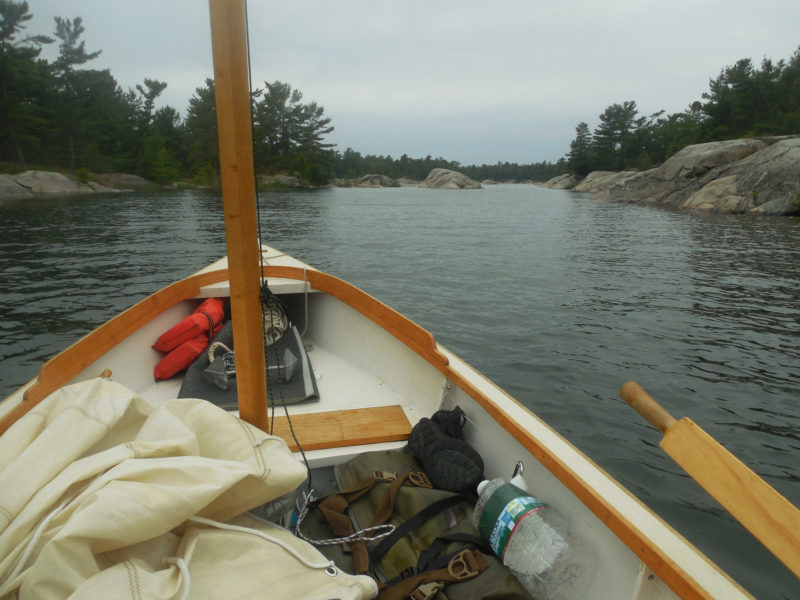 photographs by the author
photographs by the author
Join The Conversation
We welcome your comments about this article. To include a photo with your remarks, click Choose File below the Comment box.


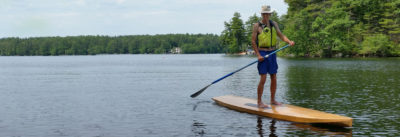
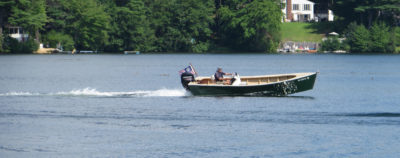
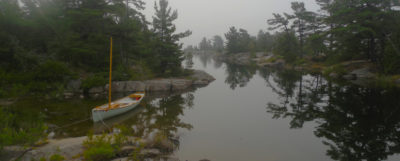
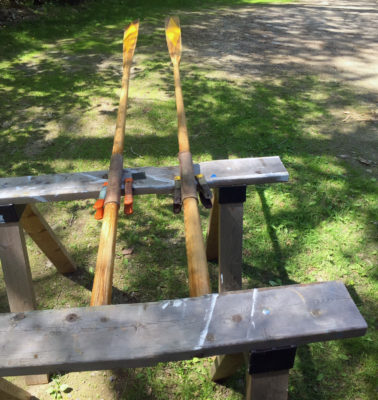
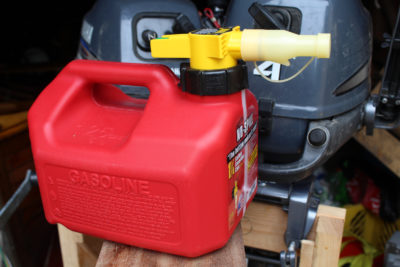
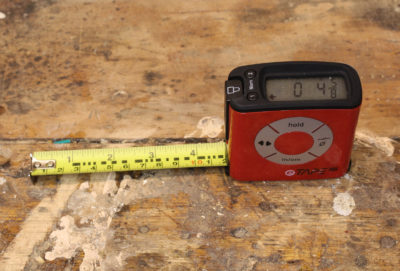
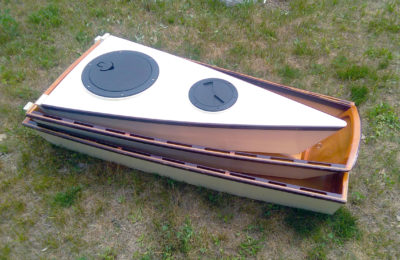
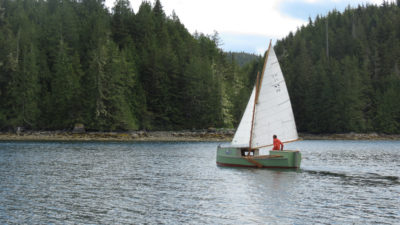

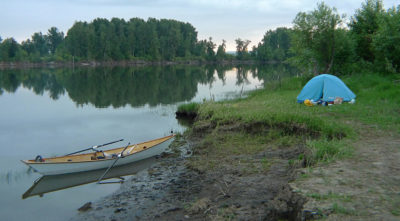
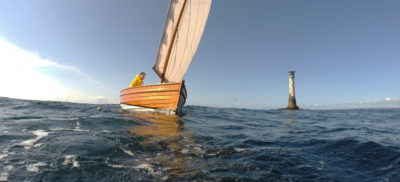
I love your article, and the Bustards are dear to my heart. Please be aware though that the Bustard Islands are part of the French River Provincial Park. Camping is only permitted in designated campsites and there is a fee per night to camp. The area is being scarred by by fire pits which leave unrepairable scars on the rocks. Enjoy the Bustards but please abide by the rules of the park.
The question of camping permits for small-boat cruising is a difficult one for me. I value the conversation and preservation efforts that permits are designed to sustain, but at the same time some permit requirements can pose difficulties.
In my experience, a permit often demands a fixed schedule, which can impose a degree of risk that I am not comfortable with. The decisions I make when traveling in a small open boat are dependent on weather conditions, visibility, and sea state. If the itinerary I’ve registered demands that I must go to a particular campsite on a particular day, but sailing to it is not safe in my judgment, then I reluctantly have to choose between breaking the rules or doing something foolish.
My own uneasy compromise, one I have arrived at after much thought and soul searching, has been to eschew official permits and keep a very low profile, including the use of minimum impact camping practices: no fires, camp on exposed bedrock, proper waste disposal, etc. I understand that’s not something everyone is comfortable with, and have no wish to persuade anyone to adopt my views. But when I am in a small boat, especially when cruising in remote or semi-remote areas, avoiding a the imposition of a rigid schedule is, I firmly believe, a significant element of my personal safety.
Having sailed the French River Delta and the Bustard Islands when no permit was required, I have the same concern as Tom. I also cherish the area but unless you use a base camp, we generally have no idea where we will be at the end of the day! It is often unlikely one can make it out to the Bustards as the weather will decide! We did make it a couple days to explore. Major Island was our camp on returning to the Delta and was wonderful but “had” a garbage dump in the ravine behind our camp! We did not add to it and no doubt it is cleaned up by now, to the credit of park staff! Here another storm had us exploring more of the back waters rather than heading south in the open. Love the area and I always buy the Provincial Park Pass (great value) but hesitate to be bound to a scheduled camp. These days it is less an issue as we generally sleep on our boat but for others it does pose problems that perhaps a solution could be found.
Best,
Roy
Roy, good to hear from you again! Thanks for sharing your thoughts, because I’m very interested to hear how others deal with the permits issue. I’d be happy to pay the fees but am not willing to commit to a rigid schedule. And with sail-and-oar boaters making up such a vanishingly small portion of visitors, I’m hesitant to talk to rangers ahead of time because I’m skeptical about the bureaucracy’s willingness to make exceptions.
Anchoring out and sleeping aboard might be a way around the letter of the law, if not the spirit.
Tom, my little Aussie battler mate from Queensland,Paul Hernes, who commissioned the design of Phoenix and built the first one, alerted me yesterday to your latest literary nautical offering which I have just finished re-living with you via another of your wonderfully flowing accounts. Your choice of photos really brings the true feel of your surroundings and are a welcome addition that helps the narrative flow and makes me feel as though I’m along for the adventure. A welcome addition to your growing collection of most enjoyable true tales. It also showcased the positive attributes of your great boat which looks to suit your purpose admirably. I look forward to reading about your next adventure. Most enjoyable. Thank you.
Al
Al,
I’m sorry for the late reply. Somehow I lost track of my notifications. Thanks very much for the kind words. Thank Paul H. for me for getting such a great design out of Ross! The Alaska is great, too.
Tom, how fun it was to run into each other in Killarney in July. I was just launching my boat SOUTHERN CROSS and there you were aboard your new ride. I concur with your take on permits for that area. I have just penned a column for Small Craft Advisor titled “Without a Trace.” It addresses the leave-no-trace question and that is precisely how I cruise—as a good citizen. We have a fine opportunity to be such good citizens precisely because we sail small. Good seeing ya mate.
Howard,
Thanks for the note. Yes, it was great to run into you and SOUTHERN CROSS, and quite a surprise as I don’t see many unconventional homebuilt small cruising boats on the Great Lakes. None, really, before running into you all this summer.
The leave-no-trace ethic is an important topic for this kind of cruising. Small boats do lend themselves to keeping a very low profile that I really appreciate.
If you do not take control over your time and your life, other people will gobble it up. If you don’t prioritize your self, you start falling lower and lower on your list.
Cap’n Rick, Port of Lewes, Delaware – a Verlen Kruger kind of paddler!
Rick,
I met Valerie Fons in Wisconsin a couple of summers ago, in the little paddling museum (really a Verlen Kruger museum) that she runs on Washington Island in Door County. She signed a copy of her book Keep It Moving: Baja by canoe, (about paddling around Baja with Verlen) to me. I hadn’t really known much about her and Verlen before that. Serious adventures they’ve had. Georgian Bay would be (is) just as good for paddling as it is for sail and oar.
Tom
Well, Tom, as is always the case, your writing and photography have transported me to a good place. For that I thank you sincerely. The pleasure your writing evokes is multi-faceted, because in addition to encouraging me to continue with my chosen form of sailing, it confirms my own convictions about small-craft design and use. Wonderful, satisfying writing.
Ross,
thanks for your kind words, and I’m glad you enjoyed the article (and glad we have Small Boats Monthly to publish it!) I sometimes almost regret ever finishing my Alaska, since I don’t have a reason to borrow my brother’s Phoenix III* anymore. Life is tough, eh?
Tom
(*a Ross Lillistone design. Ed.)
Could so easily be the Baltic. Amazing!
Roger,
I’d love to do a Baltic cruise—not much for tides there either, I suppose? That certainly simplifies things. I’ve been eyeing up the coast of Finland for years now. But of course the Great Lakes are so much closer for me…
By the way, thanks for all the videos you’ve shared about your own cruising. I’ve really enjoyed them!
Tom
Tom, I ‘m working my way through my new subscription here and, as always, enjoying your trip/trips through your words, great photos, and video!
Thanks for feeding my dreams!
Robert,
Thanks for the kind words. This was definitely one of my favorite trips ever; it was fun to write about. Let’s hope you translate dreams to reality with your own visit to Georgian Bay at some point!
Tom,
Dreams and reality are becoming one! Just noticed Roger Barnes above – both you and he have moved me to the point of choosing the Ilur, which is now 10′ from me in my garage! Last weekend I was with three gents sailing on Chester River, Maryland, and “feeling” what it is you all are going after. Been a long time since I’ve just plain chilled to that level and felt something close to actual total tranquility, inside and out. On the boat for 22 hours and…so what? Loved it. Gratitude also goes out to the Old Bay Club gents.
Wonderful read and pics; reminds me of the best of numerous kayak trips off the west coast of Vancouver Island, while showing the enchantments of a sail-and-oar cruiser.
Thank you.
Wonderful prose, beautiful pictures allow me to venture vicariously along on your adventures. Hope to sail up there someday.
Thank you ! And Chris for this forum.
Glad you have your Alaska now. Really enjoyed your article and pictures.
Hi,
I was amazed at the sheer beauty of the area I never knew. Great photos and boat. I am curious about the weight of your boat as I am looking to build but can’t find any weight
Thanks,
H
The study plans for Don Kurylko’s Alaska list the approximate hull weight as 300 lbs.
—Ed.
I’ve never weighed my Alaska, but 300 lbs sounds about right, Huw.
In practical terms, it’s so heavy that my wife and I had a hard time lifting the boat off the trailer and flipping it over for re-painting a year or so back. We managed it with just the two of us, but it wasn’t easy. It’s definitely heavy enough that rolling it up onto a beach is not a one-person operation (especially since the zero-rocker keel makes it even harder). Two people can lift and carry it for short distances when the hull is empty, but I wouldn’t want to have to move it very far.
Tom